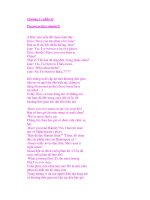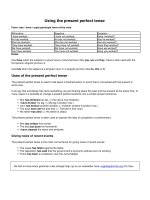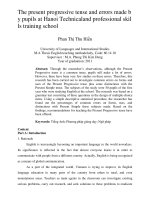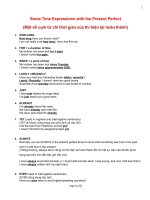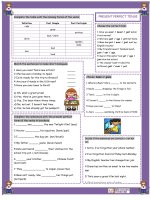The present perfect simple and continuous
Bạn đang xem bản rút gọn của tài liệu. Xem và tải ngay bản đầy đủ của tài liệu tại đây (189.21 KB, 3 trang )
25/2/2016
The Present Perfect Simple and Continuous
The Present Perfect Simple and Continuous
by Viv Quarry (www.vivquarry.com)
The present perfect is the English verb tense which speakers of Latin based languages (French, Italian, Portuguese & Spanish) find the most difficult to master. This
is because, although this tense exists in their native language in form, it is rarely used in the same way in practice. As a result of this, translating sentences in the
present perfect in English directly into these languages, will usually result in a completely different choice of verb tense.
The present perfect tense (simple and continuous), is formed using the auxiliary verb 'to have' plus the past participle of a main verb. In English, this tense has three
main uses:
With a conjunction of time to show that one action must finish before a second action can start.
To form the past tense of some modal verbs.
As a verb tense which forms a link between the past and present.
1. The present perfect simple, when used with a conjunction of time, shows that the first of two actions must be completed before the second action can start.
"The meeting will start when she arrives." (This only shows that two events happen in sequence)
"The meeting will start when she has arrived." (This means that the meeting can't start before she arrives). For more information on conjunctions of time and the
differences between the present perfect and the past simple, see Viv's 'When do I use the perfect tenses' worksheet.
2. Most modal verbs (must, should, might) do not have a past form. This type of verb can only be followed by the base form of a verb (not a past form), so the
present perfect simple and continuous are used to express the past with these verbs.
"The meeting must finish soon." (present/future)
"He's here now, so the meeting must have finished." (past)
"You shouldn't drive so fast!" (present)
"You shouldn't have been driving so fast." (past).
For more information on modal verbs and their past forms, see Viv's 'Modal verbs' worksheet.
3. The most common use of the present perfect simple and continuous is as a verb tense linking past and present actions and states. This tense is very common in
spoken English, but there are some differences between British and American English (see Viv's 'USA v UK' worksheet).
In order to help students learn this tense, I say the following questions in their native language and ask them to memorize the translation in English:
Where do you live? How long have you lived here? Why did you move here?
Have you ever been to England? When did you go there?
Have you done the homework? When did you do it?
Here are the three main uses of the present perfect simple and continuous as a verb tense:
The present perfect simple:
1) Unfinished Past
An action or state which started in the past and is NOT FINISHED.
E.g. I've lived here all my life.
This use of the present perfect simple is common with the following prepositions of time:
For = A period of time (ten years, three minutes, a long time, ages)
Since = A point in time (6pm, last year, January, my last birthday, the day I was born).
2) Life Experience
An action or state which happened at some UNSPECIFIED TIME in someone's LIFE.
E.g. I've seen this before.
This use of the present perfect simple is common with the following adverbs:
Ever = Questions (Have you ever been to Brazil?)
/>
1/3
25/2/2016
The Present Perfect Simple and Continuous
Never = Meaning 'not in my life' (I've never been to London.)
3) Present Result
An action or state which happened in the (usually recent) past and is RELEVANT NOW. This use
of the present perfect is very common in spoken English and is used for giving news.
E.g. I've done my homework.
When used to express present result, the verb 'to go' and 'to be' express different aspects:
"She's gone to New York." = She's in New York at the moment.
"She's been to New York." = She went to New York recently, but she is back again now.
Therefore, 'I've gone', You've gone' and 'we've gone' are usually unnatural in English.
Viv uses the mnemonic 'Unhappy Parrots Like Eating Pink Rabbits' to help students remember the three uses of the present perfect simple. :))
The present perfect continuous is also used for unfinished past and present result, but the main focus is on ACTIVITY and DURATION.
The Present Perfect Simple
The Present Perfect Continuous
1) Unfinished Past
There is often little difference in
meaning between the pres. perf. simp.
and cont., but unless the verb is stative,
English ALWAYS PREFERS THE
PRES. PERF. CONT. FOR
UNFINISHED PAST.
An action or state which started in the past and is NOT FINISHED.
E.g. I've lived here all my life.
E.g. I've been waiting for ages.
This use of the present perfect simple is common with the following prepositions of time:
For = A period of time (ten years, three minutes, a long time, ages)
Since = A point in time (6pm, last year, January, my last birthday, the day I was born).
2) Life Experience
An action or state which happened at some UNSPECIFIED TIME in someone's LIFE.
E.g. I've seen this before.
The present perfect continuous CAN
NOT BE USED TO EXPRESS LIFE
EXPERIENCE.
This use of the present perfect simple is common with the following adverbs:
Ever = Questions (Have you ever been to Brazil?)
Never = Meaning 'not in my life' (I've never been to London.)
3) Present Result
An action or state which happened in the (usually recent) past and is RELEVANT NOW.
This use of the present perfect is very common in spoken English and is used for giving
news.
E.g. I've done my homework.
Look at this dialogue:
A) You look tired. What have you been
doing? (*1)
B) I've been working in the garden. (*4)
A) Have you finished yet? (*2)
B) No, I haven't. I've cut the grass (*2),
but I haven't watered the flowers yet.(*3)
When used to express present result, the verb 'to go' and 'to be' express different aspects:
"She's gone to New York." = She's in New York at the moment.
The pres. perf. cont. stresses the activity
which caused the result. (*1)
"She's been to New York." = She went to New York recently, but she is back again now.
Therefore, 'I've gone', You've gone' and 'we've gone' are usually unnatural in English.
Here are the main differences between simp. and cont.
The simple focuses on the finished
action (*2)
THE PRESENT PERFECT SIMPLE:
Permanent states:
This tree has always stood in the garden.
THE PRES. PERF. CONTINUOUS:
Finished action:
Temporary actions:
I've read the book you lent me. Here it is.
They've been standing there for ages.
/>
2/3
25/2/2016
The Present Perfect Simple and Continuous
One action:
Unfinished action:
Ouch! I've cut my finger!
I've been reading the book. It's good.
Quantity: How much/many?
Repeated actions:
How many letters have you written?
I've been cutting wood.
Negatives are usually simple: (*3)
Duration: How long?
How long have you been writing?
Activities are usually continuous (*4)
For information on how to use the past simple and continuous, see Viv's Narrative Tenses worksheet.
Practice exercises for the present perfect simple and continuous.
When do I use the perfect tenses?
Back to Grammar worksheets
Home
/>
3/3


